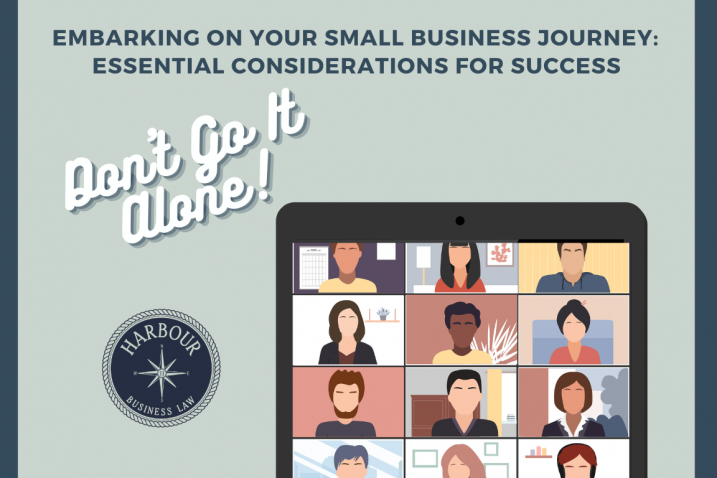
By: Katelyn J. Dougherty, Esq.
Embarking on the journey of starting your own small business can feel like a daunting task. It’s natural to be overwhelmed by questions like which industry to enter, whether your budget is sufficient, and how to attract customers. While your previous experiences may have equipped you with valuable skills, diving into the world of entrepreneurship requires a unique mindset and careful planning.
In this comprehensive guide, we will walk you through the essential aspects of launching and running a successful small business. Each section will provide you with actionable steps to take. We strongly recommend consulting local regulations and industry standards as you progress, as they may vary depending on your location.
Key Actions to Take:
LAYING THE FOUNDATIONS
The long-term prosperity of your business hinges on the decisions you make during its early stages. Consider vital aspects like the ideal location for your business and the portion of your budget you can allocate to physical space, if applicable. This section will provide you with valuable advice on premises, supplies, and leveraging technology.
Finding the Perfect Location: Whether it’s a brick-and-mortar store or an online venture, selecting the right location for your business is crucial. Assess factors such as customer accessibility, target market proximity, and cost considerations. By conducting thorough research and analysis, you can identify the optimal setting for your operations.
Action Items:
Streamline Operations with Technology: Harnessing the power of technology can significantly enhance your business’s efficiency and productivity. Embrace tools and software solutions that can streamline tasks, enhance communication with customers, and automate various processes. Stay updated on free or affordable technology-focused resources catering to small businesses.
Action Items:
Creating an Inspiring Workspace: Your workspace plays a crucial role in fostering productivity and motivation. Craft an environment that sparks creativity and aligns with your brand identity. Carefully curate your office layout, furniture, and decor to create a space that reflects your business’s vision and values.
Action Items:
Protect Your Business with Insurance: Shielding your business from potential risks is a fundamental step in securing its longevity. Research the insurance policies relevant to your industry and choose coverage that safeguards against liabilities, property damage, or unforeseen events.
Action Items:
CRAFTING YOUR BRAND
Unlike previous employment, launching your own small business empowers you to define your brand from scratch.
Your brand encompasses various elements such as name, colors, logo, fonts, and overall positioning. Consistently implementing your brand guidelines helps build a strong reputation and recognition within your target market.
Action Items:
Establishing a Memorable Brand Identity: If you’re on a limited budget, there are several cost-effective ways to develop your brand. Determine your color palette using online resources like color generators. Leverage user-friendly graphic design tools such as Canva to create a unique logo that aligns with trademark regulations. Select suitable fonts to create a cohesive visual identity for your business.
Action Items:
Building an Online Presence with a Website: In today’s digital landscape, a well-designed website is an essential asset for your business. It acts as a 24/7 virtual storefront, allowing potential customers to explore your offerings and connect with your brand. Ensure your website includes informative content about your business, testimonials, contact information, and any additional features that highlight your expertise.
Action Items:
Designing Impactful Marketing Collateral: Marketing collateral, such as brochures and business cards, serves as powerful tools to communicate your business’s value proposition and attract potential customers. Ensure your marketing materials align with your brand guidelines, utilizing consistent colors, fonts, and graphics that reflect professionalism.
Action Items:
Harnessing the Power of Local Search: When customers search for local businesses, they often turn to search engines like Google. Establishing a strong online presence, particularly through platforms like Google My Business, can significantly enhance your visibility and attract local customers. Ensure your business information is up to date, including office hours, address, and contact details.
Action Items:
DEVELOPING YOUR CLIENT BASE
As a small business owner, it’s crucial to strategize and implement effective marketing tactics to acquire and retain clients. Leverage your local network, explore digital marketing channels, and engage in community activities to grow your customer base.
Action Items:
Building Trust and Credibility: Establishing trust and credibility are paramount to attracting and retaining clients. Encourage satisfied customers to provide testimonials or online reviews that showcase your expertise and excellent customer service. Actively engage with your clients, addressing their concerns promptly and providing personalized solutions.
Action Items:
Nurturing Customer Relationships: Developing strong relationships with your customers is vital for long-term success. Implement strategies to foster loyalty and encourage repeat business, such as personalized follow-ups, loyalty programs, or exclusive offers for returning customers.
Action Items:
CONCLUSION
Starting your own small business can be a challenging yet rewarding endeavor. By carefully considering these key factors and taking proactive steps, you can lay a solid foundation for success. Remember, perseverance and adaptability are crucial in navigating the ever-evolving business landscape. Embrace the journey and stay committed to your vision, but remember, you don’t have to go it alone. Good luck!
Don’t have a business attorney? Get in touch with our team by emailing Info@harbourbusinesslaw.com.
This Blog was written by Founding Attorney, Katelyn Dougherty.
DISCLAIMER: This blog is for educational purposes only and does not offer nor substitute legal advice. This blog does not establish an attorney-client relationship and is not for advertising or solicitation purposes. Any of the content contained herein shall not be used to make any decision without first consulting an attorney. The hiring of an attorney is an important decision not to be based on advertisements or blogs. Harbour Business Law expressly disclaims any and all liability in regard to any actions, or lack thereof, based on any contents of this blog.